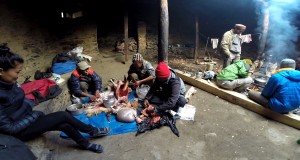We’re excited to share a new article written by one of our the researchers who went with ICI last fall as party of our Sacred Himalaya Initiative research trip to Nepal. In this piece, Jeremy Berke reflects on the experience of eating in a new place, and some of the ethical and political considerations about our food. The piece was just published on the Human Parts blog. Here’s an excerpt from his piece.
It wasn’t loud. Still, it’s pretty hard to watch
First, tie the legs. That way it doesn’t kick. If you’re around squeamish foreigners like myself, make sure the mouth is tied shut. Fear is a sensory experience; they say dogs can smell it. Rather than smell, I learned that fear has a clear and distinct sound — that of the horrible bleating of a goat on his deathbed. Growing up in Toronto, and now living in New York, empathizing with animals while receiving the majority of my protein from meat is not only considered normal, it’s encouraged. How cruel are mechanized slaughterhouses? my teachers would ask. Finish your plate, don’t let that meat go to waste, would follow shortly after.
So, tie the mouth shut. Cut off that sensory empathetic connection. Once you can’t hear, you are left to experience the goat’s fear through the other senses. Constantly suffering from hay fever, I can’t smell anything anyway. No need to worry about that. All that’s left is touch and sight. I’m not the one actually killing the poor creature (thank god), so, no touching. Now comes the hard part. Do I look away? Do I leave and come back when the living, writhing goat is reduced to a delicious cumin-scented curry?
Read the whole post here.

